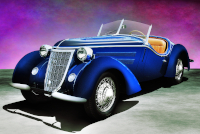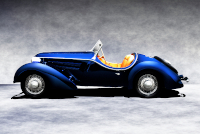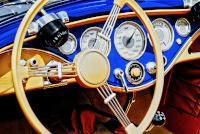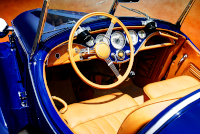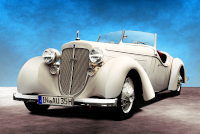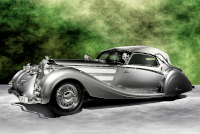Location:
Pebble Beach Concours d'Elegance, 2009
Owner: Peter Harburg | Brisbane, Queensland, Australia
Prologue:
One of the most charming little roadsters on the Pebble show field, the W25K exudes a dream-like quality; it is a quirky design, yet still somehow Teutonic. And racing aspirations aside, the W25K is one of the few pre-War German cars that appears to have been designed and built for fun.
To my mind, going back to 2009, I wanted to work up these images and profile the car because I knew it to be one of those rarities that only appears in Monterey. For some while, a much less substantive profile formed part of my old classic car project. Only 15 years later have I managed to resurrect the material and capture some of that erstwhile enthusiasm.
- - - - - - - - - -
► Image Source: Nikon D200 (10.2 MP)
References:
- Hyman Ltd: A beautifully presented W25K, beautifully photographed.
- Bonhams: A good description of chassis #252702, offered at Amelia Island in 2015.
The Wanderer W25K began as Auto Union's answer to the BMW 328. With some racing aspiration, the proto-Audi conglomerate put together a delightful little roadster, aping the Bayerische sports-racing car in proportion and approaching a similar technical specification. The results don't so much challenge the BMW in any competitive aspect, but instead create an altogether sporting road car. The W25K is spritely, though still heavier than the BMW, and also a smidge larger.
As if to concede the point, Auto Union appointed the W25K lavishly. The cockpit uses comfortable materials with polished switch gear and gauges, echoed by ornamental coachwork crafted by Wendler. No such niceties on the BMW 328, which is a spartan racing instrument in comparison.
Which brings us around to the premise: The W25K is one of very few pre-War German cars built for fun; it is a showcase of Auto Union style in the same tradition as the grand Horch 853 cabriolet, and also a noteworthy piece of sports car technology.
Ferdinand Porsche contributed to the W25K specification, notably (according to most sources) by adding a Roots-type supercharger to the alloy inline 6-cylinder motor. And this contribution makes the W25K part of the Porsche sporting lineage.
From a historical standpoint, a pre-War Auto Union project with Porsche engineering presages the 21st century mergers that brought Audi and Porsche together under the Volkswagen banner. The people and technology cross-pollinated over a century prior, with projects capitalizing on shared ideas under Daimler, Auto Union, Porsche, and eventually Volkswagen nameplates.
German industry advanced collaboratively, rather in direct contrast to Britain's man-in-a-shed approach to auto manufacture, fueled in no small part by government funding. Auto Union products are therefore testaments to the power of economies of scale. And where so many German badges became synonymous with war machines in the years following the classic era, it is nice to remark upon a product of beauty, the W25K, which seems to exist for no other reason than to bring us joy.
Only that there were too few of these roadsters produced, and little exposure of the marque outside German borders. So the BMW and Wanderer share a sense of obscurity. Neither BMW nor Auto Union entered the export market to any significant degree, and neither would have been known to a pre-War American audience.
But this is the crux, that pre-War German industry served a national lust for power, and its products therefore served a great and meaningful purpose—to mobilize the masses, to bury the competition, and to impress the elite. And yet the W25K is none of those things; it exists within a sliver of the German psyche that is fun for fun's sake. Perhaps not so rare today, a sentiment gradually drawn out of the German auto industry through decades of Beetle production, in the 1930s this sort of frivolity is verboten. And so the W25K is proof that, even then, Germans could be a lot of fun when they wanted to be.
Motor: 1,962 cc straight 6-cylinder, aluminum block and head | 70 mm x 85 mm
Valvetrain: OHV, 2 valves per cylinder
Aspiration: Solex double-barrel updraft carburetor, Roots-type supercharger
Power: 85 bhp @ 4,000 rpm
Drivetrain: 4-speed gearbox, rear-wheel drive
Architecture: tubular steel chassis
Kerb Weight: 1,050 kg (2,314.8 lbs)
Wheelbase: 2,650 mm (104.3 inches)
Top Speed: 145 km/h (90.9 mph)
Etymology:
As with many period automakers, the 'W' stands for 'wagen,' German nomenclature for 'car.' When appended by a number, as in 'W25,' the designation defines the project (car 25). The number is a serial designation, more administrative than technical.
Also common to German cars, the 'K' indicates a supercharger, or kompressor.
I have seen the car referred to as just the W25K Sports, omitting 'roadster,' but ostensibly the same.
Figures:
Wanderer produced no more than 258 examples of the W25K, offered as a roadster from 1936 with a naturally aspirated cabriolet later joining the rank. Few of either version survive.
853 Diminutive: Common Design Themes among Horch and Wanderer
Though different coachbuilders leant their skill to Auto Union products, these cars exhibit a uniform design lexicon. The W25K designed and built by Wendler resembles cabriolet exercised developed by Gläser on the Audi platform, as well as the grand designs of Horch provided by the likes of Erdmann & Rossi.
Most notably, chrome binding wraps around the nose, lines the bonnet, and then wraps around the passenger compartment. This wrap concept appears in near identical form on Horch 853 models by Erdmann & Rossi, and to some extent Voll & Ruhrbeck, where chrome binding that begins at the front forms a loop somewhere aft. In this sense, the W25K is quite deliberately a diminutive version of the Horch.
W25K Identity: Heraldic Grandeur versus Whimsical Spirit
While bonnet louvres follow a Teutonic pattern of two closely oriented rows along the flank, the grille distinguishes the Wanderer from its Auto Union stablemates. This unit is absolutely a heraldic shield.
Almost too tall for the vehicle's proportions, the grille establishes an impressive fascia and raises the bonnet. But this grand posture gives the car enough height to create a dramatic sweep down through the doors and around the passenger compartment.
Being so little, this design element is twice as dramatic on the W25K as it is on the Horch 853, which looks classically elegant in comparison. And this touch of whimsy is what makes the W25K such fun despite the chrome armour that dominates its fascia. Auto Union meant to impress, but the true nature of the design is that of a clever little roadster.
Bauhaus Aerodynamics: Subtle Purpose in the W25K Design
Less apparent than the heraldic shield, the W25K uses circular valances to shroud the space between the fenders and the body. The shape is barrel-like, divided along the middle of each shroud by a body-moulded joint, with the inner pieces tapering toward the grille.
This design element appears to be a Bauhaus remnant on an otherwise classic era form. Circular chrome vents reinforce the theme. As if to say that a car is defined by the wheel, and therefore its ultimate formal reduction is a circle, these fascia components fit well within the Bauhaus lexicon.
This aerodynamic treatment is also the chief component that ties the production W25K to the one-off W25K streamlined special. In this case, German aerodynamics are wholly purposeful, dispensing with multiplanar undulations in deference to simple circles.
We know this design philosophy from the more recent Audi TT, circa 1998. Here in the classic era, Bauhaus has given way to classical beauty. Only these few cues remain, and they are subtle, snug between the skirts and that massive chrome grille.
Dash Beautiful: German Style in the Classic Cockpit
Among classic era motorcars, the German knack for turning chrome and painted sheet metal into functional artwork is remarkable. And among classic German cars, the W25K is one of the most extraordinary designs.
The layout includes an undulating wave in chrome, central instrument display in cobalt to match the body, and clean proportional crescents to either side finished in a peculiar blond cream to complement the leather and the wheel rim. The wheel itself provides filigree shadow through its chrome banjo strings and trefoil fret bars, and the shift knob sneaks out close to hand with an unapologetically legible shift gate diagram.
Closer, the gauges are clear and pretty with a distinct watch face influence, (though the combined oil and fuel gauge is slightly reminiscent of the combination gauges on the Alfa 8C 2900). Where insignia, lettering, and pattern are vital to the enjoyment of a fine watch, the same impression applies to the gauge set.
One could find bliss behind the steering wheel of a W25K, enjoying the whiz of a supercharged inline 6-cylinder, minding the measures on the prettiest dashboard of any classic automobile.
Last Updated: Mar 26, 2025

